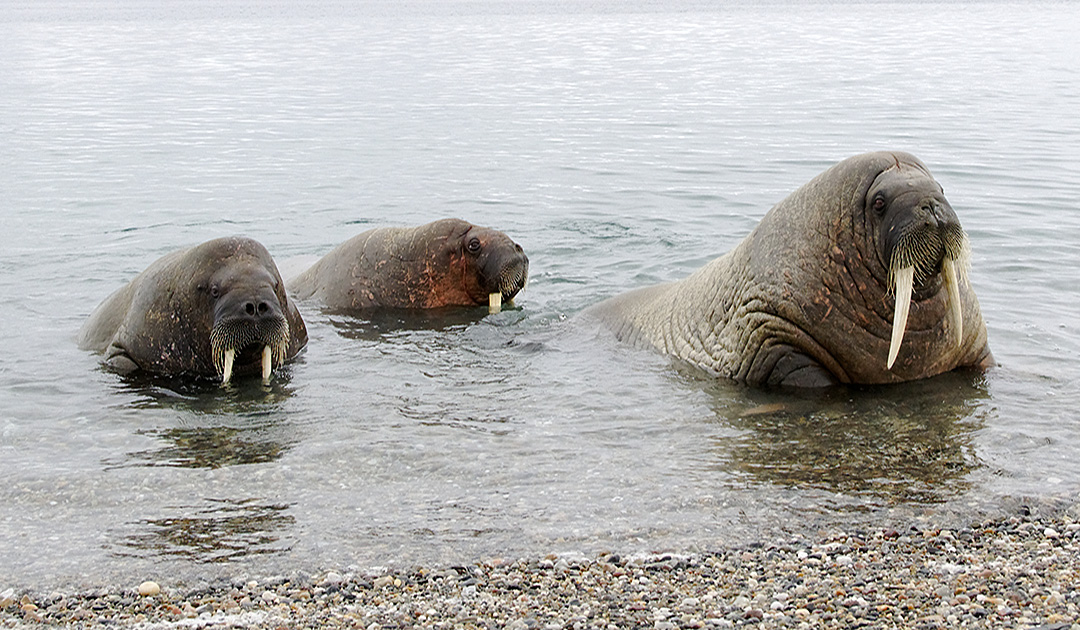
Walruses were once abundant in the Svalbard archipelago, but 350 years of unchecked hunting brought them to the brink of extinction. Walruses have been protected since 1952. That year, the Norwegian government banned commercial hunting of these endangered creatures. The population at that time was only 100. Since 1970, a slow recovery of the population has been recorded, with 741 walruses counted in 1993.
Several studies documented that walruses in Svalbard are part of a larger, joint Svalbard-Franz Josef Land population. The increase in Svalbard stocks was largely due to ‘immigrants’ from Franz Josef Land.
The gender balance in the Svalbard region was highly skewed in the decades between the 1950s and 1990s. Most of the walruses that returned to the archipelago were males. Females were almost exclusively confined to a few refugia in the northeast corner of Nordaustlandet and comprised only a few percent of the population.

Counts brought clarity
The first systematic census was conducted in 2006. This survey covered all 79 known terrestrial haul-out sites in Svalbard during a narrow time window of 1-3 August. Seventeen retreats had been occupied by animals when the survey flights were conducted. The photos of the active sites showed 657 animals. An extensive behavioural data set from satellite relay data loggers was used to record animals that had been in the water at the time of the survey. The resulting estimate was 2,629 animals.
The second survey was conducted in 2012 and the new estimate was 3,886 walruses. At that time, 91 resting sites were registered in the Polar Institute’s terrestrial exit database. Twenty-four of them were occupied during the investigation. Females with calves were identified with at nine of the sites, compared with just one site in the 2006 survey.
The third survey was carried out in 2018. That survey estimates that there are 5,503 walruses in the Svalbard area. This is an increase of 41.6% on the previous count. Animals were present at 19 of the resting places visited, and calves were observed at seven of them. In 2018, there were 98 walrus haul-out refugia in the Svalbard database.

Walruses are divided into two subgroups
There are an estimated 20,000-30,000 Atlantic walrus (Odobenus rosmarus rosmarus). The walruses of Svalbard belong to this subgroup. Its habitat ranges from the central Canadian Arctic through Greenland and Svalbard to the Russian Kara Sea east of Novaya Zemlya. While males measure 3.5 metres in length and weigh up to 1,500 kilograms, the females with their body length of 2.5 meters and a weight of 700-900 kilograms seem downright dainty. Even further east on the northern coast of Siberia, one encounters the Laptev walrus (Odobenus rosmarus laptevi), which is sometimes cited as a third subspecies.

And about 200,000 Walrus belonging to the subspecies of the Pacific walrus (Odobenus rosmarus divergens) are found in the Bering Strait region between Russia and Alaska . They are noticeably larger than their European relatives. A male of this subspecies easily weighs 1,700 kilograms and reaches a body length of 4 meters. Also the teeth are longer with the Pacific walrus and appear therefore nicely bent outwards or turned apart (lat. divergens). Typical of this subspecies are the photos that we have all seen somewhere: wide beaches, of which you actually see nothing — because every square meter is occupied by a fat, pink walrus and thousands of these animals crowd into the picture.
Heiner Kubny, PolarJournal





